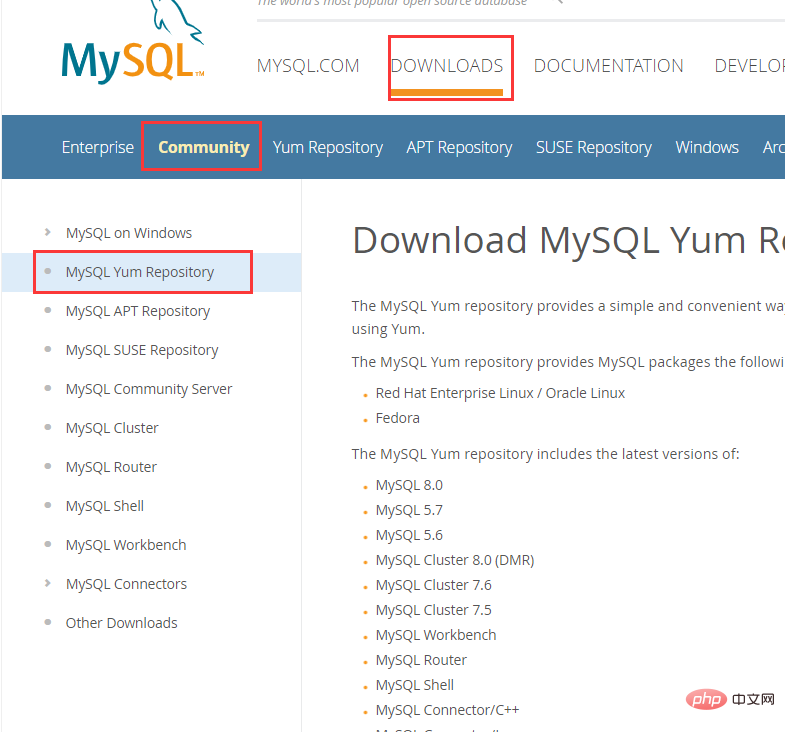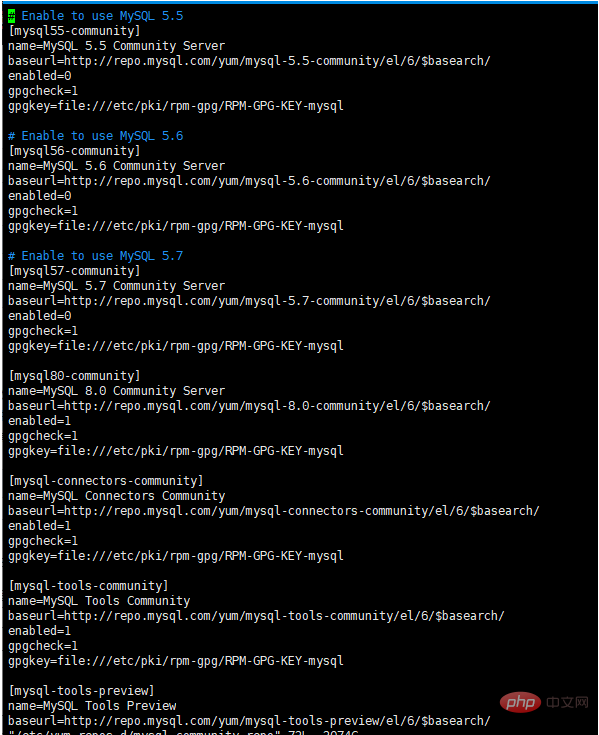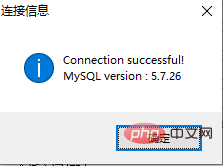How to install mysql on centos 6.5?

How to install mysql on centos 6.5:
1. Upload related packages (*.tar.gz, etc.)
Use relevant software to upload or use Xshell to connect and download the command: yum install lrzsz
2. Install mysql5.7
1. Check whether mysql is installed locally: rpm -qa | grep mysql
2. Uninstall the local mysql: yum remove mysql package
3. Download the installation package from the official website yum repository : wget http://dev.mysql.com/get/mysql80-community-release-el6-3.noarch.rpm
or download manually And upload it to linux

Then select

I am using CentOS6.5 here, all download this
4. Install the downloaded rpm package
yum localinstall mysql80-community-release-el6-3.noarch.rpm
5. Check the available installation packages
yum repolist enabled|grep mysql

6. Next, you need to change the mysql version
vim /etc/yum.repos.d/mysql-community.repo

For example, to install version 5.7, change the enabled=1 of the 80 source into enabled=0. Then change the enabled=0 of the 5.7 source to enabled=1.
7. Install mysql
yum install mysql-community-server -y
8. Start mysql and change related configurations
1>Start mysql: service mysqld start
2>Check whether mysql starts automatically, and set it to enable automatic startup
chkconfig --list | grep mysqld
chkconfig mysqld on
3>View initial password: grep "password" /var/log/mysqld.log

4>Log in to mysql: mysql -u root -p
5>Change password: SET PASSWORD FOR 'root'@'localhost' = PASSWORD('123456');
If the modified password is too simple, an error may be reported:
ERROR 1819 (HY000): Your password does not satisfy the current policy requirements
Execute the following statement:
set global validate_password_policy=0;
set global validate_password_length=4;
Execute the modify password statement again

6>Open root account remote access
grant all privileges on *.* to 'root'@'%' identified by '123456' with grant option;
7>Refresh permission table
FLUSH PRIVILEGES;
8>Modify the character set to UTF-8
linux: vim /etc/my.cnf
Add in the [mysqld] section:
port=3306
character-set-server=utf8
Add the [client] section at the end of the file and add in the [client] section:
port=3306
socket=/var/lib/mysql/mysql.sock
default-character-set=utf8
Add in the [mysql] section:
no-auto-rehash
default-character-set=utf8
After modification, restart the mysqld service:
service mysqld restart
(Import the sql script, first use the database, then source /home/sql/test.sql)
9>Use software to test remote connection to mysql

Recommended tutorial: "centos tutorial"
The above is the detailed content of How to install mysql on centos 6.5?. For more information, please follow other related articles on the PHP Chinese website!

Hot AI Tools

Undress AI Tool
Undress images for free

Undresser.AI Undress
AI-powered app for creating realistic nude photos

AI Clothes Remover
Online AI tool for removing clothes from photos.

Clothoff.io
AI clothes remover

Video Face Swap
Swap faces in any video effortlessly with our completely free AI face swap tool!

Hot Article

Hot Tools

Notepad++7.3.1
Easy-to-use and free code editor

SublimeText3 Chinese version
Chinese version, very easy to use

Zend Studio 13.0.1
Powerful PHP integrated development environment

Dreamweaver CS6
Visual web development tools

SublimeText3 Mac version
God-level code editing software (SublimeText3)
 How to use check constraints to enforce data rules in MySQL?
Aug 06, 2025 pm 04:49 PM
How to use check constraints to enforce data rules in MySQL?
Aug 06, 2025 pm 04:49 PM
MySQL supports CHECK constraints to force domain integrity, effective from version 8.0.16; 1. Add constraints when creating a table: Use CREATETABLE to define CHECK conditions, such as age ≥18, salary > 0, department limit values; 2. Modify the table to add constraints: Use ALTERTABLEADDCONSTRAINT to limit field values, such as name non-empty; 3. Use complex conditions: support multi-column logic and expressions, such as end date ≥start date and completion status must have an end date; 4. Delete constraints: use ALTERTABLEDROPCONSTRAINT to specify the name to delete; 5. Notes: MySQL8.0.16, InnoDB or MyISAM needs to be quoted
 Best Practices for Managing Large MySQL Tables
Aug 05, 2025 am 03:55 AM
Best Practices for Managing Large MySQL Tables
Aug 05, 2025 am 03:55 AM
When dealing with large tables, MySQL performance and maintainability face challenges, and it is necessary to start from structural design, index optimization, table sub-table strategy, etc. 1. Reasonably design primary keys and indexes: It is recommended to use self-increment integers as primary keys to reduce page splits; use overlay indexes to improve query efficiency; regularly analyze slow query logs and delete invalid indexes. 2. Rational use of partition tables: partition according to time range and other strategies to improve query and maintenance efficiency, but attention should be paid to partitioning and cutting issues. 3. Consider reading and writing separation and library separation: Read and writing separation alleviates the pressure on the main library. The library separation and table separation are suitable for scenarios with a large amount of data. It is recommended to use middleware and evaluate transaction and cross-store query problems. Early planning and continuous optimization are the key.
 How to implement a tagging system in a MySQL database?
Aug 05, 2025 am 05:41 AM
How to implement a tagging system in a MySQL database?
Aug 05, 2025 am 05:41 AM
Useamany-to-manyrelationshipwithajunctiontabletolinkitemsandtagsviathreetables:items,tags,anditem_tags.2.Whenaddingtags,checkforexistingtagsinthetagstable,insertifnecessary,thencreatemappingsinitem_tagsusingtransactionsforconsistency.3.Queryitemsbyta
 How to Troubleshoot Common MySQL Connection Errors?
Aug 08, 2025 am 06:44 AM
How to Troubleshoot Common MySQL Connection Errors?
Aug 08, 2025 am 06:44 AM
Check whether the MySQL service is running, use sudosystemctlstatusmysql to confirm and start; 2. Make sure that bind-address is set to 0.0.0.0 to allow remote connections and restart the service; 3. Verify whether the 3306 port is open, check and configure the firewall rules to allow the port; 4. For the "Accessdenied" error, you need to check the user name, password and host name, and then log in to MySQL and query the mysql.user table to confirm permissions. If necessary, create or update the user and authorize it, such as using 'your_user'@'%'; 5. If authentication is lost due to caching_sha2_password
 Implementing MySQL Data Lineage Tracking
Aug 02, 2025 pm 12:37 PM
Implementing MySQL Data Lineage Tracking
Aug 02, 2025 pm 12:37 PM
The core methods for realizing MySQL data blood ties tracking include: 1. Use Binlog to record the data change source, enable and analyze binlog, and trace specific business actions in combination with the application layer context; 2. Inject blood ties tags into the ETL process, and record the mapping relationship between the source and the target when synchronizing the tool; 3. Add comments and metadata tags to the data, explain the field source when building the table, and connect to the metadata management system to form a visual map; 4. Pay attention to primary key consistency, avoid excessive dependence on SQL analysis, version control data model changes, and regularly check blood ties data to ensure accurate and reliable blood ties tracking.
 What is the difference between TRUNCATE, DELETE, and DROP in MySQL?
Aug 05, 2025 am 09:39 AM
What is the difference between TRUNCATE, DELETE, and DROP in MySQL?
Aug 05, 2025 am 09:39 AM
DELETEremovesspecificorallrows,keepstablestructure,allowsrollbackandtriggers,anddoesnotresetauto-increment;2.TRUNCATEquicklyremovesallrows,resetsauto-increment,cannotberolledbackinmostcases,doesnotfiretriggers,andkeepstablestructure;3.DROPremovesthee
 How to upgrade a MySQL server to a newer version?
Aug 03, 2025 am 09:04 AM
How to upgrade a MySQL server to a newer version?
Aug 03, 2025 am 09:04 AM
CheckcompatibilitywithOS,applications,andfeatures;2.Backupalldata,configs,andlogs;3.Chooseupgrademethod(packagemanager,MySQLInstaller,ormanual);4.Runpost-upgradechecksandtests;5.Resolveissueslikeauthenticationpluginsordeprecatedoptions.Alwaysbackup,t
 How to show all databases in MySQL
Aug 08, 2025 am 09:50 AM
How to show all databases in MySQL
Aug 08, 2025 am 09:50 AM
To display all databases in MySQL, you need to use the SHOWDATABASES command; 1. After logging into the MySQL server, you can execute the SHOWDATABASES; command to list all databases that the current user has permission to access; 2. System databases such as information_schema, mysql, performance_schema and sys exist by default, but users with insufficient permissions may not be able to see it; 3. You can also query and filter the database through SELECTSCHEMA_NAMEFROMinformation_schema.SCHEMATA; for example, excluding the system database to only display the database created by users; make sure to use







